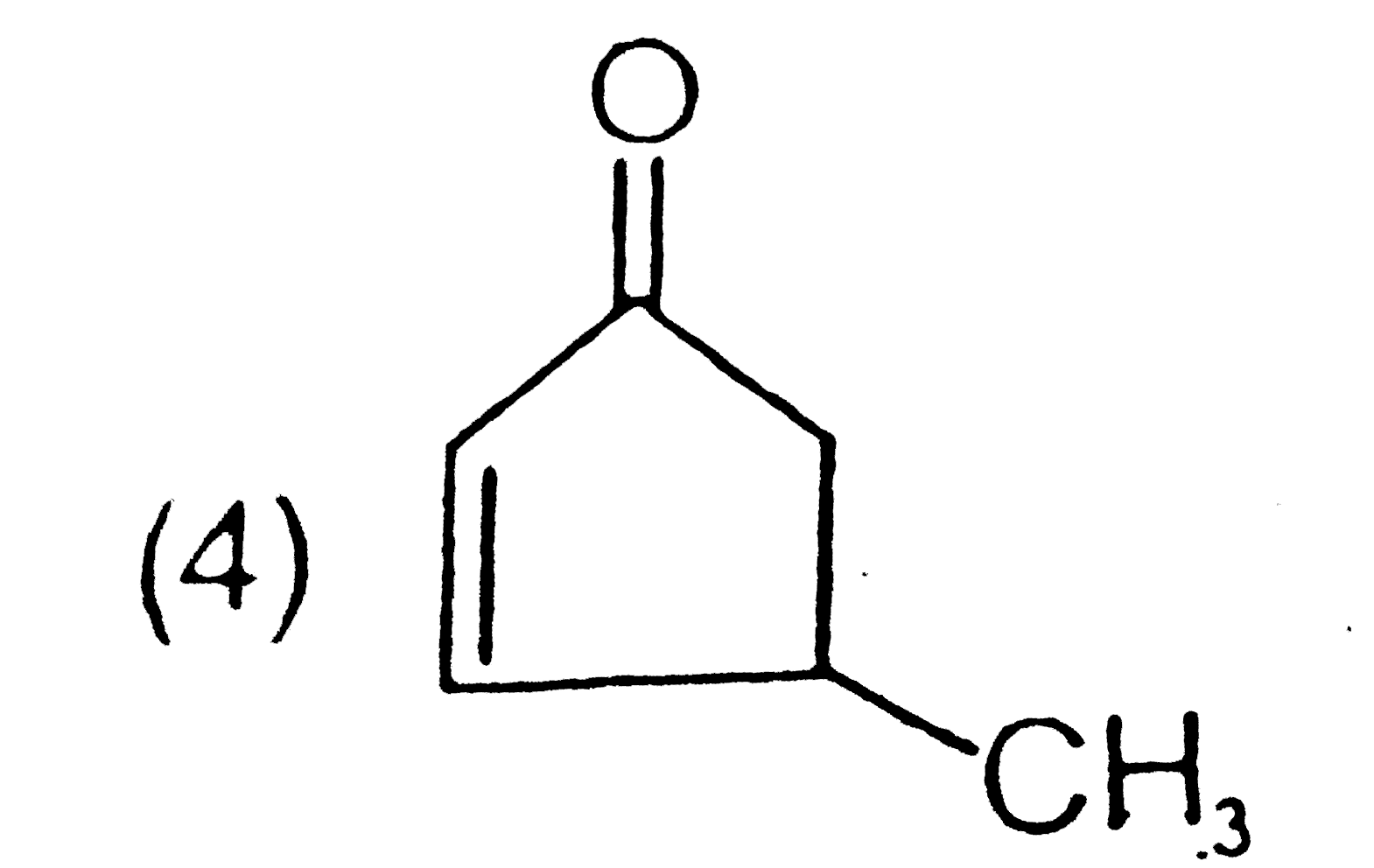The diketone CH3−O∣∣C−(CH2)2−O∣∣C−CH3 on intermolecular aldol condensation gives the final product




The correct Answer is:C
To solve the problem regarding the diketone undergoing intermolecular aldol condensation, we will follow these steps:
Step 1: Identify the Structure of the Diketone
The diketone is represented as:
CH3C(=O)(CH2)2C(=O)CH3
This structure consists of two carbonyl (C=O) groups and a chain of two methylene (CH2) groups between them.
Step 2: Understand the Aldol Condensation Mechanism
In aldol condensation, a base abstracts a proton from the alpha carbon (the carbon adjacent to the carbonyl group), generating an enolate ion. This enolate ion then attacks the carbonyl carbon of another molecule of diketone.
Step 3: Form the Enolate Ion
Using a base (e.g., OH⁻), we abstract a proton from one of the CH2 groups adjacent to the carbonyl:
CH3C(=O)CH2C(=O)CH3
This leads to the formation of the enolate ion:
CH3C(=O)C(−)H2C(=O)CH3
Step 4: Nucleophilic Attack
The enolate ion attacks the carbonyl carbon of another diketone molecule:
CH3C(=O)CH2C(=O)CH3+CH3C(=O)CH2C(=O)CH3
This results in a new β-hydroxy ketone.
Step 5: Formation of the Five-Membered Ring
The aldol product can cyclize to form a five-membered ring. The nucleophilic attack leads to the formation of a five-membered ring structure:
Cyclization occurs, leading to a structure like:
Cyclic structure: CH3−C−(CH2)−C(=O)−CH3
Step 6: Dehydration
Upon heating or treatment with a concentrated acid, dehydration occurs, leading to the elimination of water and formation of a double bond:
Final product: 3-methylcyclopent-2-en-1-one
Step 7: Naming the Product
The final product can be named based on its structure:
- The compound is a cyclopentene with a ketone group and a methyl substituent.
- The final IUPAC name is 3-methyl-3-cyclopent-2-en-1-one.
Summary of the Final Product
The final product of the intermolecular aldol condensation of the diketone is:
3-methyl-3-cyclopent-2-en-1-one
---
The diketone is represented as:
CH3C(=O)(CH2)2C(=O)CH3
This structure consists of two carbonyl (C=O) groups and a chain of two methylene (CH2) groups between them.
In aldol condensation, a base abstracts a proton from the alpha carbon (the carbon adjacent to the carbonyl group), generating an enolate ion. This enolate ion then attacks the carbonyl carbon of another molecule of diketone.
Using a base (e.g., OH⁻), we abstract a proton from one of the CH2 groups adjacent to the carbonyl:
CH3C(=O)CH2C(=O)CH3
This leads to the formation of the enolate ion:
CH3C(=O)C(−)H2C(=O)CH3
The enolate ion attacks the carbonyl carbon of another diketone molecule:
CH3C(=O)CH2C(=O)CH3+CH3C(=O)CH2C(=O)CH3
This results in a new β-hydroxy ketone.
The aldol product can cyclize to form a five-membered ring. The nucleophilic attack leads to the formation of a five-membered ring structure:
Cyclization occurs, leading to a structure like:
Cyclic structure: CH3−C−(CH2)−C(=O)−CH3
Upon heating or treatment with a concentrated acid, dehydration occurs, leading to the elimination of water and formation of a double bond:
Final product: 3-methylcyclopent-2-en-1-one
The final product can be named based on its structure:
- The compound is a cyclopentene with a ketone group and a methyl substituent.
- The final IUPAC name is 3-methyl-3-cyclopent-2-en-1-one.
The final product of the intermolecular aldol condensation of the diketone is:
3-methyl-3-cyclopent-2-en-1-one
Topper's Solved these Questions
- ALDEHYDES, KETONES AND CARBOXYLIC ACIDS BOOK - AAKASH INSTITUTE ENGLISHCHAPTER - ALDEHYDES, KETONES AND CARBOXYLIC ACIDS EXERCISE - Assignment (SECTION -B OBJECTIVE TYPES QUESTIONS (ONE OPTION IS CORRECT)
24 Videos
- ALDEHYDES, KETONES AND CARBOXYLIC ACIDS BOOK - AAKASH INSTITUTE ENGLISHCHAPTER - ALDEHYDES, KETONES AND CARBOXYLIC ACIDS EXERCISE - Assignment (SECTION -C Objective type questions more than one options are correct)
11 Videos
- ALDEHYDES, KETONES AND CARBOXYLIC ACIDS BOOK - AAKASH INSTITUTE ENGLISHCHAPTER - ALDEHYDES, KETONES AND CARBOXYLIC ACIDS EXERCISE - Illustrations
3 Videos
- ALCOHOLS, PHENOLS AND ETHERS BOOK - AAKASH INSTITUTE ENGLISHCHAPTER - ALCOHOLS, PHENOLS AND ETHERS EXERCISE - Try Yourself
5 Videos
- AMINES BOOK - AAKASH INSTITUTE ENGLISHCHAPTER - AMINES EXERCISE - Assignment Section -J (Aakash Challengers Questions)
9 Videos
Similar Questions
Knowledge Check
The IUPAC name for CH3−O∣∣C−CH2−CH2−O∣∣C−OH is ______.
A1-hydroxypentane-1,4-dioneB1,4-dioxopentanolC1,carboxybutan-3-oneD4-oxopentanoic acidCH3−O∣∣C−H and Ph−O∣∣C−H can be differentiated by :
ATollen's reagentBFehling's solutionCLucas reagentDVictor meyer's testH3C−CH2−O∣∣C−CH3ϴOD/D2−−−−→ Final product is
AH3C−CD2−O∣∣C−CH3BCH3−CH2−O∣∣C−CD3CD3C−CD2−O∣∣C−CD3DCH3−CD2−O∣∣C−CD3
